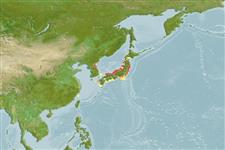Élasmobranches (requins et raies) (sharks and rays) >
Rajiformes (Skates and rays) >
Arhynchobatidae (Softnose skates)
Etymology: Bathyraja: Greek, bathys = deep + Latin, raja, -ae = a ray (Raja sp) (Ref. 45335); caeluronigricans: Named for the purplish black color of the dorsal side of the disk (Ref. 75535).
Issue
This species is a synonym of Bathyraja matsubarai (Ishiyama, 1952) after Last et al. (2016: Ref. 113540)
Environment: milieu / climate zone / depth range / distribution range
Écologie
marin démersal; profondeur 200 - 400 m (Ref. 58018). Temperate
Northwest Pacific: north of Tôhoku, Japan to the Sea of Okhotsk.
Taille / Poids / Âge
Maturity: Lm ? range ? - ? cm
Max length : 74.4 cm WD mâle / non sexé; (Ref. 75535); 72.2 cm WD (female)
Description synthétique
Clés d'identification | Morphologie | Morphométrie
This species is distinguished from its congeners in Bathyraja in having a dark purplish brown color on both sides of the body; the spiracle is longer than eyeball and with deep concavity at their anterior part; clasper with a deep cleft; dense silky fibers cover the egg capsule (Ref. 75535).
Oviparous (Ref. 50449). Eggs have horn-like projections on the shell (Ref. 205).
Life cycle and mating behavior
Maturities | Reproduction | Spawnings | Egg(s) | Fecundities | Larves
Oviparous, paired eggs are laid. Embryos feed solely on yolk (Ref. 50449). Eggs have horn-like projections on the shell (Ref. 205).
McEachran, J.D. and K.A. Dunn, 1998. Phylogenetic analysis of skates, a morphologically conservative clade of elasmobranchs (Chondrichthyes: Rajidae). Copeia 1998(2):271-290. (Ref. 27314)
Statut dans la liste rouge de l'IUCN (Ref. 130435)
Menace pour l'homme
Harmless
Utilisations par l'homme
Outils
Articles particuliers
Télécharger en XML
Sources Internet
Estimates based on models
Phylogenetic diversity index (Ref.
82804): PD
50 = 0.5000 [Uniqueness, from 0.5 = low to 2.0 = high].
Bayesian length-weight: a=0.00513 (0.00253 - 0.01042), b=3.12 (2.95 - 3.29), in cm total length, based on LWR estimates for this Genus-body shape (Ref.
93245).
Niveau trophique (Ref.
69278): 4.0 ±0.7 se; based on size and trophs of closest relatives
Résilience (Ref.
120179): Faible, temps minimum de doublement de population : 4,5 à 14 années (Fec assumed to be <100).
Fishing Vulnerability (Ref.
59153): High to very high vulnerability (66 of 100).
